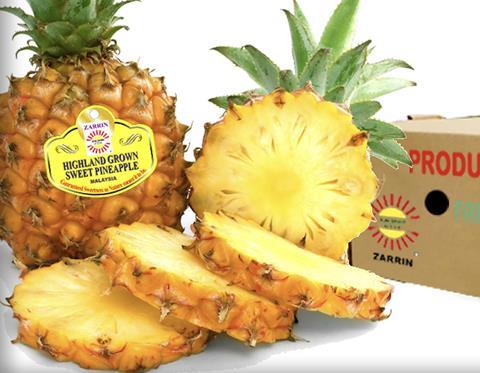Before Donald Trump scuppered the Iran nuclear deal, pineapple exports came to Iran from sources including Thailand, Malaysia and Sri Lanka, but since then Philippines has been the only reliable supplier
Unlike the turbulence witnessed in Iran’s banana import market, pineapples have been consistently supplied to Iran for the most part by the Philippines for the past decade, with volumes growing by almost sixfold in this time, according to Alireza Emami, CEO of Iranian trader Zarrin Group.
“Based on the latest data, the Philippines stands as the largest producer of pineapples, growing around 2.7m tonnes, closely followed by Costa Rica with over 2.6m tonnes per year,” said Emami. “The best quality pineapples are cultivated in Costa Rica, but unfortunately Iran is yet to receive any volumes.”
Due to direct, almost biweekly chartered vessels from the Philippines to Iran, Filipino pineapples have been able to maintain their top ranking on the Iranian market. “Other suppliers like Thailand and Malaysia have exported minor volumes to Iran, but discontinued in 2019 when shipping lines halted their services to Iran,” explained Emami.

For a time, he said, Ecuador developed a share of the Iranian banana market at the expense of the Philippines, but was hamstrung by a very long transit time and a shorter shelf-life.
“After the 2015 Joint Comprehensive Plan of Action (JCPOA) to monitor and regulate Iran’s nuclear programme, with shipping services widely available, countries like Sri Lanka, India, Hong Kong and China started exporting to Iran,” added Emami, “but Trump’s decision to withdraw from the nuclear agreement brought this to an end.”
During a trip to Malaysia, with the aim of transferring Malaysian experience in banana production to India and using Malaysian operational teams to help boost Indian banana exports to Iran, Emami said he became acquainted with the N36 pineapple.
“Zarrin Group was the first to introduce and import N36 pineapples from Malaysia to markets in the Middle East including Iran,” he said. “These pineapples are mainly cultivated in the Malaysian state of Johor. This variety, with its hard core, less flesh and protruding eyes on the peel, could be supplied at a cheaper price compared with the MG3 (Gold) variety. It was suitable for middle range buyers and also the fruit processing industry.”
However, when sanctions returned and shipping lines stopped their services to Iran, imports of this variety also came to a halt, according to Emami. Pineapple imports from Latin America do still make their way to Iran via Mersin in Turkey, he said, but volumes remain limited.



